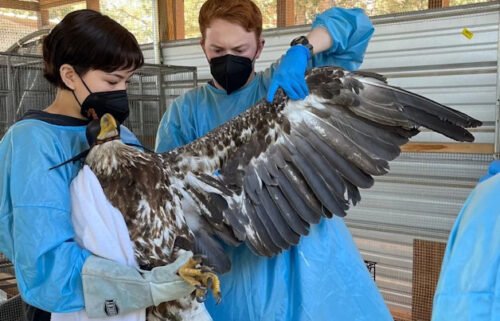Deschutes improves to ‘High Risk,’ indoor dining to return; Crook, Jefferson still ‘Extreme’
(Update: Adding Restaurant and Lodging Assn. news release)
Limits on business occupancy will rise, long-term care indoor visits allowed
SALEM, Ore. (KTVZ) -- Gov. Kate Brown announced Tuesday that 12 counties, including Deschutes, have improved in risk level, with 10 moving out of Extreme Risk for the first time since November, effective Friday, with loosening restrictions and indoor dining again allowed.
County risk levels under the state's public health framework aim to reduce transmission and protect Oregonians from COVID-19. The framework uses four different risk levels for counties based on COVID-19 spread—Extreme Risk, High Risk, Moderate Risk, and Lower Risk—and assigns health and safety measures for each level.
Effective Feb. 12-25, there will be 14 counties in the Extreme Risk level, 11 at High Risk, two at Moderate Risk, and nine at Lower Risk. A complete list of counties and their associated risk levels is available here (a later correction was made for Harney County, keeping them in the lower risk level).
Counties improving from Extreme to High Risk include Clackamas, Clatsop, Columbia, Hood River, Klamath, Linn, Multnomah and Washington.
Two counties move to Moderate Risk: Lake (moved from Lower) and Morrow (moved from Extreme). Two counties improve to Lower Risk, Baker (from High) and Grant (from Moderate).
As the Oregon Health Authority's Sector Risk Level Guidance Chart shows, the big changes moving from Extreme to High Risk are up to eight people (from six) allowed in outdoor social and home gatherings, allowing indoor dining (with takeout still highly recommended) and larger outdoor seating capacity.
Indoor recreation, fitness and entertainment establishments will be allowed at maximum 25% of capacity or 50 people total, whichever is smaller (and an 11 p.m. closing time for entertainment businesses). Outdoor recreation, fitness and entertainment establishments move from a 50-person maximum to allowing up to 75 people.
In the workplace, under High Risk, OHA still recommends -- but will no longer require -- remote work, if able, and offices no longer need to be closed to the public, if possible. Long-term care facilities, which were limited to outside visitation only, will be allowed to have inside visitation once again.
“Thanks to Oregonians who have stepped up and made smart choices, we have made incredible progress in stopping the spread of COVID-19 and saving lives in Oregon," Brown said, "This week, we will see 10 counties move out of Extreme Risk, including the Portland tri-county area, for the first time since November. This is welcome news, as we'll start to see more businesses open up and Oregonians being able to get out a bit more.
"It’s also incredibly important that we continue to remain vigilant and protect our neighbors and loved ones as we face virulent new strains of COVID-19. This means continuing to wear masks, keep our physical distance, and avoid indoor gatherings. If we want to keep businesses open, reopen schools for in-person instruction, and stay safe, we must keep up our guard. Until vaccines are more widely available, case counts could go back up if we don't keep following safety measures."
The Oregon Health Authority will examine and publish county data weekly. County risk levels will be reassigned every two weeks. The first week's data will provide a "warning week," to prepare counties for potential risk level changes. The next assignment of risk levels will be announced Feb. 23 and take effect Feb. 26.
Updates to Warning Week data and county risk levels will be posted to coronavirus.oregon.gov.
News release from the Oregon Restaurant & Lodging Association:
| Indoor Dining Back for Most of Oregon A Total of 22 of Oregon’s 36 Counties Open for Indoor Dining Friday Wilsonville, OR– Hundreds of Oregon restaurants will open their doors to indoor dining starting Friday, February 12 as case counts per 100,000 residents drop below the coveted 200 case mark over the course of the previous two weeks in specific counties. As industry suppliers and restaurant owners scramble to safely open for indoor dining, two prevailing issues remain – continuity of restaurant operations and getting employees back on the schedule. “Today’s announcement represents a significant step in the right direction,” said Jason Brandt, President & CEO for the Oregon Restaurant & Lodging Association. “It’s our job to make sure the Governor’s Office and Oregon’s Legislators understand what we think will happen next because of today’s news. Top on the list are the challenges facing small businesses attempting to manage two weeks of operational certainty at a time which includes finding workers who are trying to pay monthly bills. And we must acknowledge the 14 counties with restaurant operations still trying to survive in the winter with no indoor dining.” Opening and closing restaurant operations continues to be cited as the number one challenge facing the industry with the biggest issues revolving around worker schedules and forecasting food supply needs in a limited time period once announcements on changes are made. “It is our job to be there for our workers and we will be doing our best to explain the uncertainty surrounding future work schedules,” said Dan Lenzen, Co-Owner of Dixie Tavern in Portland. “I hope our ability to open indoors represents a turning point allowing us to be open longer than two weeks. To stay in business, we need the ability to safely use some of the space inside our restaurant consistently and provide the jobs that go along with it.” February 12 appears to represent a key marker in the fight to mitigate virus spread as most Oregonians will now have indoor dining back as an option in their community for the first time in months. Still, restaurant operators in 14 counties continue to rely on Payroll Protection Program funds, limited outdoor operations if available, and takeout/delivery to scrape by. Approximately 38 percent of Oregonians still live in a county where indoor dining is not currently available. “We continue to be faced with incredible headwinds in the restaurant industry with the ban on indoor dining in Marion County,” said Conrad Venti, Co-Owner of Venti’s Taphouse and Basement Bar. “Every change we have managed as a company has impacted our employees just as much. We have permanently lost several long-term employees, including management, who have chosen to move on to other industries because of the complete instability and continuous changes we’ve had to face in the last year.” “With recent numbers trending in the right direction I was hopeful we would be inviting our guests and community back in to dine with us, and bringing employees back to work,” said Kevin Boyles, Co-Owner of Sassy Onion Restaurant in Salem. “Being in the extreme risk category while most of the state reopens is even more frustrating knowing my long time customers are able to make a small trip and enjoy a dining experience elsewhere, while my business continues to suffer.” ORLA is mounting a grassroots effort of industry professionals this week to continue encouraging outreach to Oregon’s Legislators and Governor Brown’s professional staff given the clear divide being experienced in a state with just over half its restaurants open while the others attempt to hold on. “We know firsthand how difficult it is for Oregon’s restaurant industry to ramp up their businesses two weeks at a time,” said Brandt. “Our goal in facilitating ongoing communication is to provide our elected leaders and their professional staff with the personal stories behind these challenges in hopes of providing more runway and a glide path for work schedules Oregonians can rely on. The easiest way to accommodate this would be to move to a system based on Low, Moderate, and High COVID-19 risk in each county and eliminate the Extreme Risk category altogether. Having three levels of risk instead of four would provide an additional level of flexibility needed as restaurants continue their fight for survival.” For more information on the efforts of the Oregon Restaurant & Lodging Association please visit OregonRLA.org. ### The Oregon Restaurant & Lodging Association is the leading business association for the foodservice and lodging industry in Oregon, which before COVID-19 provided over 180,000 paychecks to working Oregonians. According to the Oregon Employment Department’s December data, over 50,000 Oregonians that once had a job in hospitality do not have work available to return to. |



